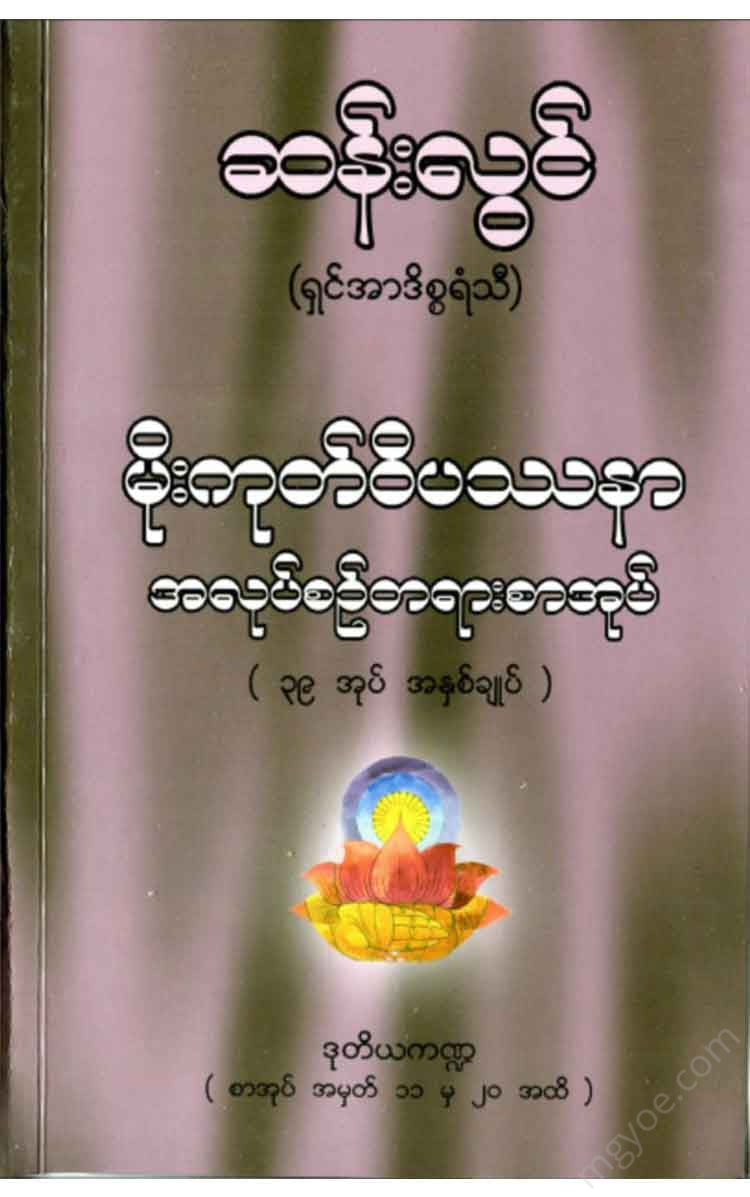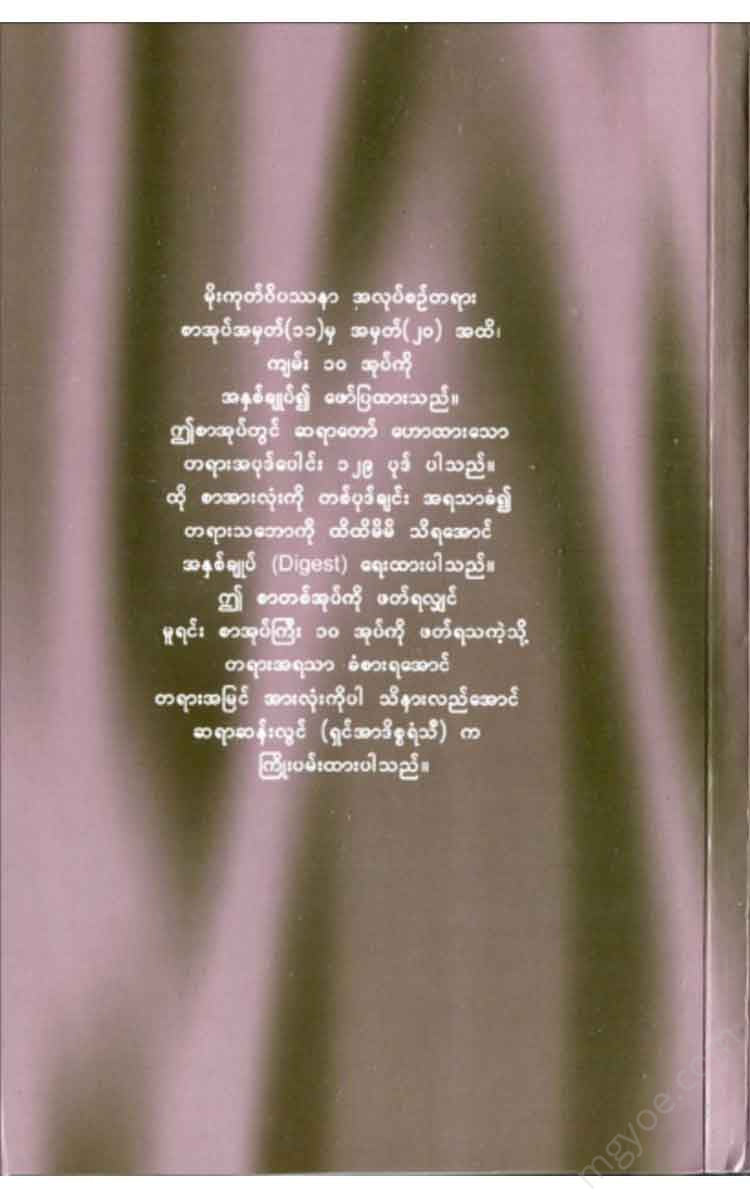Other Websites
San Lwin - Summary of Moe Kot Vipassana Practice Part 2
San Lwin - Summary of Moe Kot Vipassana Practice Part 2
Couldn't load pickup availability
Mogok Vipassana Meditation Practice Book No. (11)
Introduction
The teachings of the great monk Mogok Sayadaw are intended to fill the gaps in the lives of Buddhists and to improve them. He preached that before giving charity, before practicing virtue, before practicing meditation, before practicing insight, one should first do the removal of delusion. The cycle of existence is caused by delusion. Delusion is the barrier between the mind and the body. Nibbana is achieved through the removal of delusion. There are three ways to remove delusion. The way to remove delusion from knowledge, the way to remove delusion from the body, and the way to remove delusion from the path. These are the yanataparinya, the tiranaparinya, and the pahanaparinya.
The venerable Sayadaw preached in the Dispensation of Discipline based on the great doctrine of the Pathis Samuppada. He emphasized the attainment of the truth and the divine knowledge. A good teacher is a good practitioner who knows the truth.
By listening to the Dhamma preached, one can attain enlightenment. This book states that only by doing Vipassana meditation can one attain enlightenment.
Of the sermons in this book, number (11), the first sermon from number (1) to number (4) was preached on the dates 14-6-62 to 17-6-62. It appears that these were preached at the wedding hall in Mogok. The three sermons from number (5) to (7) have no date. It appears that these were preached at the wedding hall in Mogok.
However, it is stated that the Dhamma of the 8th series, Cittanupassana, was preached on 17-6-62. Since the Dhamma of the 4th series was also preached on 17-6-62, it is also stated that the date is the same, and it is a night-time sermon. If there were two sermons on the same day, it would have to be a day sermon and a night sermon. Something must be wrong. A Dhamma called Cittanupassana is also mentioned in the 3rd series, Dhamma of the 10th series. The title is the same, but the way of preaching is different. It must be a sermon for each sermon.
In this book , the Dhamma titled “Open the Two Covers and See Nibbana” given on 18-6-62 was given in Book No. (8), Discourse No. (2) on 16-11-61. The titles are the same. It is possible that the same Dhamma was preached twice. The Dhamma on 16-11-61 was preached at the Dhamma Hall in Amarapura. The Dhamma on 18-6-62 was preached at the Mingalar Taki in Mogok, so it is likely that it was preached twice in two places.
1. The Law of Freedom from Chaos
[Sermon preached at the wedding hall in Mogok on 14-6-62]
This verse begins with a word that encourages those who practice meditation to strive. He explains that no matter how much charity one gives, one cannot escape the danger of falling into the abyss, and since one cannot escape the danger of falling into the abyss if one dies as a mortal, one should prioritize the danger of falling into the abyss. The meaning is that one should not die as a mortal, but rather die as a sotapan. [No. 3] The story of how the great monk Erakapatta became a sea dragon in the Dhammapada shows how one cannot escape the danger of falling into the abyss no matter how much virtue one cultivates. The question should be asked, how can one escape the danger of falling into the abyss and the abyss? One should try to understand the path of the body. If you do not know the origin of the body, no matter what you do or give, it is a form of charity led by ignorance. Only by knowing the truth and building a temple for the Buddha is the path of wisdom. Only that path of wisdom leads to Nibbana.
If you do wholesome actions led by ignorance, you will also be tempted and conditioned, and you will be led to the state of conflict. Only when you are led by wisdom can you control your desires, control your conditioning, and control your karma. Conflict is broken. The Buddha said, "Don't believe what anyone says, but believe only what your own conflict is showing you." He also urged you to first do the work of liberation from the danger of falling into the four realms. (Page 15). - The entire conflict is just the body. The realm is carried by the conflict. If you know that conflict is one and that one is broken,
It is said that it is close to the Sotapan. [No. 18) If there is a small amount of hearing in the ear, then a small amount of anger arises. Because of anger, sorrow arises. All kinds of suffering, suffering, and sorrow arise. This is the process of one's own body (patissamuppada). Knowing one's own mind, one's own process is wisdom. When one knows that one's own body is one and the other is broken, that knowledge cuts off the next process of conflict.
Only when the next conflict is broken can the danger of falling into chaos be prevented. (Nah-19) The blind mind does not have the knowledge to know that. Only when insight knowledge arises can one see through one's own mind and know it. If one knows the conflict, one knows the origin and the end. [Nah-21) Knowing that the origin is a new suffering, a new suffering, is the truth of the path of wisdom. That knowledge (the path of wisdom) intervenes and prevents the conflict from going ahead.
He also openly states that if you know this, you will become a noble person. (p. 22) He also explains by reference that “the Buddha says that a person who knows his own origin is free from the danger of chaos.” (p. 23) He also states that “there is no danger of chaos in the Sotāpana , ‘Avinipāta Dhamma, Niyātāva Sambodhiprayana’.”
The main thing to do is to know how the mind arises and how it ceases, and how the pain arises and how it ceases. (Page 25) If you know the process of your body in this way, you have cut off your own entanglements. It is said that a person who cuts off in this way will no longer have to worry about whether he will be reborn after death. [Page 26]
Do not dwell in vain. If you observe the mind, you should be aware of every thought
The purpose of the sermon, the monk said, is to give priority to acquiring that knowledge and understanding, and to put children, women, and business aside. [Page 29]
Then he presents the Dhamma story that comes from the Sotapatta Magga Samyot. When he arrives at a village where there are many brick kilns, the monks tell him a list of those who have died in their village and ask him what state of life those people have reached. After a while, the Buddha cannot answer, because he has too much to answer, so he stops answering and preaches the Dhamma method that allows one to decide for oneself whether one will fall into the realm of bliss or not.
It teaches how to decide which life one will go to after death through the perspective of the path of conflict. It shows how those who cross the path of conflict and those who cannot cross it go to the realm of the dead when they die, and how those who can cross it go to the realm of bliss when they die. It teaches how one can know for oneself. [Page 37] It teaches how one can escape from the chaos of existence if one has the wisdom to cross the path of conflict.
Then, a living person has six kinds of attachment points: eye, ear, tongue, nose, body, and mind. The six kinds of attachment points arise from the six double openings. If you do not want to cut off the kamma that leads to happiness, you must cut off the kamma that leads to misery. (Nā-44) If you can cut off the kamma that leads to happiness, you will attain Nibbāna quickly. If you want to attain Nibbāna quickly, you must cut off kamma. (Page 45) This is the true knowledge that knows the nature of one's own life. It is also decided that this knowledge is the seed knowledge of the Sotapa. (Page 47) It is also specifically stated that the knowledge that is being observed in this way is the knowledge of the Suṭa Sotapa. If one dies with this knowledge of the Suṭa Sotapa, one will attain bliss in the next life. When one attains bliss, one will surely attain the Great Sotapa, and one will surely attain it. The time has come to listen to the Dhamma.



